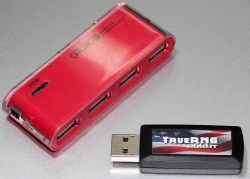Azure Developer Associate certification
Thursday, June 27. 2019
Yup.

Passed that one yesterday. For those intersted, it was a AZ-203: Developing Solutions for Microsoft Azure exam.
Previous one was 21 years ago:
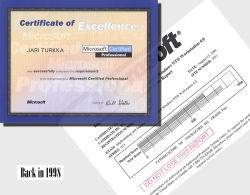
Notice how they misspelled my name. Argh! ![]()
I bet many of you haven't used Windows NT4.0 Workstation for a while (or ever).
Also notice how the certification was issued by Mr. Bill Gates himself! ![]()
EBN European Business Number scam - Part 4 - Epic win!!
Tuesday, June 25. 2019
Couple weeks ago, a good friend of this blog, Mr. Gorila approached with his comment (available at https://blog.hqcodeshop.fi/archives/372-comments.html#c2786). He suggested, that our beloved friends at DAD Gmbh were in some sort of financial trouble. I did some digging of my own, but given the huge handicap of me not knowing any German language nor corporate laws or practices of Germany, I found nothing. Today, Mr. Gorila approached me again with proof.
EBN scammers are Bankrupt!
Its obvious, that the people behind the scam went nowhere. They're still there and are cooking up something while trying to maintain the scam from Cyprus. There are comments from people, who received letters from debt collectors operating from Cyprus. The "debt" in question is from EBN scam and is somehow transferred from DAD Gmbh to CLB Solutions Management.
Regardless of these events, my advice is unchanged: Keep your cool and
DO NOT PAY!
There seems to be increasing amounts of proof of malpractice by DAD Gmbh. Their "debts" are completely ficticious and there is no way they can win anybody in a court of law in Germany. They need to sue your ass in Germany court, and that's there they will lose. They already did that and will keep losing. Actually, "they" don't even manage the company anymore. The company is to be dissolved by court order and liquidation is handled by somebody else than the scammers.
Proof
For those wanting to see the proof, go to https://www.bundesanzeiger.de/ and make a search for "DAD Deutscher Adressdienst". You will receive search result page:
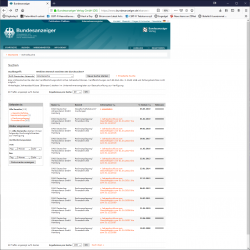
The first result will be the official notification of company liquidation. If you click the link, the text simply says the company will be dissolved and all creditors should contact the company.
More interesting is their balance sheet from year 2017 (printed into PDF by me DAD-scam-Bundesanzeiger-DAD-balance-sheet-2017.pdf). That piece of criminal history needs to stay available as long as there is Internet and human life on Earth.
My most important findings are:
- Scammers have almost 1 million € in accounts receivable. That's ficticious "debt" from marks they scammed.
- Its obvious, that majority of that "income" will never land at their bank accounts. DO NOT PAY!
- Company has nearly 250.000 € cash available
- Two options here: Their liquidation hit them as a surprise or they are really bad at crime.
- It makes no sense to leave any easy-to-move assets to the company.
- Besides the 25.000 € initial capital, that's the profit from their crime. I imagined more.
- Their accumulated operating loss is nearly 100.000 €
- I don't think they ever targeted for profit.
- In a company, it is very easy to avoid taxes by never making any profit out of the operation.
- Stated in balance sheet details: There are almost 400.000€ liabilities remaining
- Given the coarse nature of a balance sheet, I cannot deduce much from that besides they owe more money than they have.
- That kinda explains the liquidation.
Future
They're already running a new scam. It's called European Register of Commerence or ERC. The webpage looks like this:

Its simply a spin-off from EBN-scam with a GDPR-twist.
Participate!
Anybody of you can participate in fighting these scammers. I'm maintaining the Finnish Wikipedia page for EBN scam to have a reputable source of information available with a really good Google page rank. Page is at: https://fi.wikipedia.org/wiki/European_Business_Number
You can do the same in your language!
Keep people informed about these scams. That will make the work for those scammers harder and harder. Many readers have shared information in comments of my blog, please keep doing that! There are people including me, who will investigate your clues and raise awareness of these scams and what happens in the scam'osphere.
Thank you!
Trigger Azure CDN to update certificate to custom domain from Key Vault
Tuesday, June 18. 2019
I've said this multiple times: Everything in cloud computing is at least twenty times more complex than it used to be with your old-fashioned regular servers couple years ago. Things are complicated with physical servers too, but when you apply a cloud and don't have a server you could touch even if you wanted, the fog in your cloud just complicates every trivial thing. This is one of those overly-complex things I ran into and needed to get solved.
So here goes:
What happens when you combine short-lived HTTPS-certificates from Let's Encrypt with Azure Content Delivery Network?
Yeah. Misery.
Given the maximum time-span of three months for this free-of-charge certificate issued by Let's Encrypt ACME-system, a simple wish of making sure the most recent certificate is in use by Azure CDN proved to be much trickier than it needs to be. You would assume, that Azure-people understand the need to eventually have a new certificate running. The need is same for everybody, no matter where the cert came from. Yet again, assumption seems to be the mother of all f...ups.
Azure CDN users Azure Key Vault as a source of any custom certificate used by your custom domain at CDN endpoint. Uploading a X.509 certificate to Azure Key Vault is nearly trivial. You have the PKCS#12 file, upload it and boom! Done!
The next step proved to be nearly impossible. You need to inform CDN, that a new certificate is available and kindly suggest to start using it. CDN won't detect this change automatically, as I initially assumed.
After failing on my every attempt, as a last resort I posted the question in Stackoverflow, Update Azure CDN custom domain certificate from a script. As you might expect, the things I typically do with computers are on the more difficult side. The law of the ICT-jungle says: When questions are difficult, the answers are even more. This is something I knew at the time of posting the question, there are not too many people who would be able to solve my issue, or even fully comprehend the question.
Eventually I lucked out and Mr. Singh replied.
His suggestion seemed valid at a glance. The complexity hit me at the same glance. Instantly it became obvious, that testing the suggested action will not be easy. It took me a while to process all the required information/parameters/requirements, then wait for new certificate update cycle, craft a suitable approach to verify his suggestion. Eventually everything aligned just right. A new certificate was issued, I put some effort into investigating the suggested course of action and finally succeeded in my script-crafting and proved Mr. Singh suggestion to correct. The CDN Custom Domain API does work as he suggested. Go see it for yourself, the API docs are at https://docs.microsoft.com/en-us/rest/api/cdn/customdomains/enablecustomhttps.
My resulting PowerShell 6 script is at https://gist.github.com/HQJaTu/c5695626ba51c6194845fa60913e911b, go get it there.
For those trying to reason my choice of scripting tool, it's obvious: PowerShell Core runs on Azure Cloud Shell (go to https://shell.azure.com/ if you have an Azure account). Such scripts can be run on any browser capable of connecting to Azure. And yes, I do run Bash on everywhere, but I tend to NOT write scripts with it. Python or PowerShell have so much elegant approach on the important things, like error handling.
systemd setting overrides
Monday, June 17. 2019
In couple past posts of mine, I've instructed people to do alter systemd service descriptions. Examples from Randomness in computers and Handling /run with systemd. As we all know, systemd is quite a beast. It just keeps on giving complexity as we stumble along trying to grasp all of it.
For example:
To add more command arguments to rngd.service, you can do what I instructed earlier. You can copy /usr/lib/systemd/system/rngd.service to /etc/systemd/system/, edit the file and do a systemctl daemon-reload to update the changes.
If you want to choose more systemd'ic (Python developers always say "pythonic") way, you can do a:
systemctl edit rngd
This command will open a text-editor. The editor is your default one from EDITOR environment variable, or if you haven't picked one, a default will be chosen for you by your favorite Linux distro vendor.
What you should make the text file contain, is following three (3) lines:
[Service]
ExecStart=
ExecStart=/sbin/rngd -f --rng-device=/dev/TrueRNG --fill-watermark=4000
Those lines will re-define service description. First by clearing out the previous value(s) and then defining a new one. On save, this setting will take automatically effect and you don't have to do anything else. Also, this setting is persisted in a file called /etc/systemd/system/rngd.service.d/override.conf. Of course, you can create that particular file yourself, but then the familiar systemctl daemon-reload is needed to make your changes stick.
Nice and easy! ![]()
New microphone
Monday, June 10. 2019
It's not that you'd be talking all the time, but quite often a good microphone is needed. It may be (video)conferencing to somebody or just to get your multiplayer game coordinated with the other people you're playing with. Lot of people are happy using the tiny mic in their headphones, but not me. I'd rather invest some real money to a proper piece of hardware to get my sound transmitted over crystal clear.
Since I didn't want to go for ridiculously expensive studio ones, I stayed below 300 € price range and went for a Røde NT-USB (details are at https://www.rode.com/microphones/nt-usb). The microphone would work as a self-standing desk mic, but adding a few options allows me to amp up the experience to a near-studio -quality.
This is what my rig looks like:

As you can see, there is a PSA1 boom arm and a SMR shock mount to keep the sound quality better when I bang the desk in rage.
The metal ring used to fasten the microphone to a stand gives you indication of the quality of this product. No messing around here. No flimsy plastic screws. Steel!
Also the acronym USB gives you a hint about how you might connect this lump of metal to a computer, using USB 2.0 interface on the bottom of the microphone. If this would be professional-quality, instead of USB-B connector, you would use for example XLR-connector for cabling. This would leave you to do the analog-to-digital -conversion by yourself. I chose this particular unit for the reason it hooks up to your PC/Mac/Linux/whatever directly. Here no extra stuff needed, but the setup is limited by USB's 5 meter max. cable length. There is plenty of USB-cable in the box, so don't worry about running out.
Shock mount is for reducing any possible noise caused by accidental headbump into desk or microphone. As suggested, the mount absorbs most of the shock and not transmitting really weird noises over. This is how the "cradle" looks like:
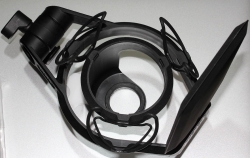
There is a windshield reducing any air blowing from me towards the microphone. Again, reducing any weird noises sounding like I was hit by a hurricane to being transmitted over. The shock mount connects to the boom arm using a 5/8" (or 3/8") screw:
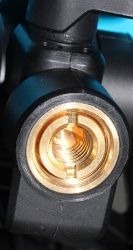
As you can see, there is an adapter there allowing you to use pretty much any mic boom of your choice. I chose to go full on with Røde.
Important thing is to note, that manufacturer does NOT recommend using SMR shock-mount with NT-USB microphone. Product details at https://www.rode.com/accessories/smr do NOT list NT-USB as being compatible or related product. The reason is not as dramatical as you might think. The products are compatible, but:
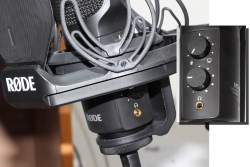
In a scenario, where you would use the USB to transmit sound back to your headphones via 3.5mm jack in the mic, it would be difficult for you to change the headphones volume as the volume knobs aren't that easy to access. You can access them, but not as well as manufacturer would love you to. So, they simply flag the products as "incompatible".
Ultimately, I've been really happy with the product. My sound is heard extremely well on the other side. Helping with this is the boom arm, which lets me place the microphone to almost any location of my choosing while doing my computing, whatever type of computing that might be. The best thing is the very high quality of the product. I don't think I'll be buying a new mic anytime soon.
Vim's comment line leaking fix! Part 3
Wednesday, June 5. 2019
Many years ago I was pissed off by Vim's change to start "leaking" comments. If you hit enter on a comment line, Vim's artificial stupidity system deduces, that the next line is also a comment and "helps" you by adding a comment character for you. If you are copy/pasting stuff, which is already formatted, all you'll get is bunch of garbage. The obvious fix is to run a colon (:)-command: :set formatoptions-=cro
Even that failed at some point, but luckily they made changes to get that working again. My old post from year 2013 is here:
Quite soon you'll find out, that you need to m a n u a l l y do that every single time you start editing a file. Argh! Annoying. There must be a way to change something in a configuration file to keep the thing working properly.
In Stackexchange, there is an article set formatoptions in vimrc is being ignored. Yes, just having set formatoptions-=cro in your ~/.vimrc (or ~/.vim/vimrc) won't fix the problem. From the article you find out, that in Vim, there is an after plugin/file type/etc. config-file. Yet again, having a ~/.vim/after/ftplugin.vim containing the precious set formatoptions-=cro will NOT fix the issue.
A second Stackexchange article Why does Vim ignore files in ~/.vim/after/ftplugin? yields almost nothing useful. Almost. By running suggested :scriptnames you will find out, that after/ftplugin.vim is run on a rather low priority. Much before the file-type plugin for chosen language.
Here is an example, I was editing a Ruby-file (extension .rb). When the file was open in Vim, :scriptnames output would say:
1: /etc/vimrc
2: /usr/share/vim/vim74/syntax/syntax.vim
3: /usr/share/vim/vim74/syntax/synload.vim
4: /usr/share/vim/vim74/syntax/syncolor.vim
5: /usr/share/vim/vim74/filetype.vim
6: /usr/share/vim/vim74/ftplugin.vim
7: ~/.vim/after/ftplugin.vim
8: ~/.vim/vimrc
9: /usr/share/vim/vim74/plugin/getscriptPlugin.vim
10: /usr/share/vim/vim74/plugin/gzip.vim
11: /usr/share/vim/vim74/plugin/matchparen.vim
12: /usr/share/vim/vim74/plugin/netrwPlugin.vim
13: /usr/share/vim/vim74/plugin/rrhelper.vim
14: /usr/share/vim/vim74/plugin/spellfile.vim
15: /usr/share/vim/vim74/plugin/tarPlugin.vim
16: /usr/share/vim/vim74/plugin/tohtml.vim
17: /usr/share/vim/vim74/plugin/vimballPlugin.vim
18: /usr/share/vim/vim74/plugin/zipPlugin.vim
19: /usr/share/vim/vim74/syntax/ruby.vim
20: /usr/share/vim/vim74/ftplugin/ruby.vim
There is no way for my "suggestion" to affect the Ruby file-type plugin. It is ran last with highest possible priority!
This time I was ready to go all the way. If fixing this would require making changes to Vim source code, I was ready for battle. Bring it on Vim! Bring your A-game!
My initial weapon-of-choice is mostly strace. It revealed following:
stat("/usr/share/vim/vimfiles/after/syntax/syncolor.vim", 0x7fff45b
stat("/home/joeuser/.vim/after/syntax/syncolor.vim", 0x7fff45bf5610
openat(AT_FDCWD, "/usr/share/vim/vimfiles/after/ftdetect/", O_RDONL
openat(AT_FDCWD, "/home/joeuser/.vim/after/ftdetect/", O_RDONLY|O_N
stat("/usr/share/vim/vimfiles/after/filetype.vim", 0x7fff45bf5f10)
stat("/home/joeuser/.vim/after/filetype.vim", 0x7fff45bf5f10) = -1
stat("/usr/share/vim/vimfiles/after/filetype.vim", 0x7fff45bf6fb0)
stat("/home/joeuser/.vim/after/filetype.vim", 0x7fff45bf6fb0) = -1
stat("/usr/share/vim/vimfiles/after/ftplugin.vim", 0x7fff45bf6fb0)
stat("/home/joeuser/.vim/after/ftplugin.vim", {st_mode=S_IFREG|0644
stat("/home/joeuser/.vim/after/ftplugin.vim", {st_mode=S_IFREG|0644
stat("/home/joeuser/.vim/after/ftplugin.vim", {st_mode=S_IFREG|0644
stat("/home/joeuser/.vim/after/ftplugin.vim", {st_mode=S_IFREG|0644
open("/home/joeuser/.vim/after/ftplugin.vim", O_RDONLY) = 4
stat("/home/joeuser/.vim/after/ftplugin.vim", {st_mode=S_IFREG|0644
openat(AT_FDCWD, "/usr/share/vim/vimfiles/after/plugin/", O_RDONLY|
openat(AT_FDCWD, "/usr/share/vim/vimfiles/after/plugin/", O_RDONLY|
openat(AT_FDCWD, "/home/joeuser/.vim/after/plugin/", O_RDONLY|O_NON
openat(AT_FDCWD, "/home/joeuser/.vim/after/plugin/", O_RDONLY|O_NON
stat("/usr/share/vim/vimfiles/after/syntax/ruby.vim", 0x7fff45bf3b5
openat(AT_FDCWD, "/usr/share/vim/vimfiles/after/syntax/ruby/", O_RD
stat("/home/joeuser/.vim/after/syntax/ruby.vim", 0x7fff45bf3b50) =
openat(AT_FDCWD, "/home/joeuser/.vim/after/syntax/ruby/", O_RDONLY|
...
stat("/root/.vim/ftplugin/ruby.vim", 0x7ffd6abd1990) =
stat("/usr/share/vim/vimfiles/ftplugin/ruby.vim", 0x7ff
stat("/usr/share/vim/vim74/ftplugin/ruby.vim", {st_mode
open("/usr/share/vim/vim74/ftplugin/ruby.vim", O_RDONLY
stat("/usr/share/vim/vim74/ftplugin/ruby.vim", {st_mode
...
stat("/usr/share/vim/vimfiles/after/ftplugin/ruby.vim", 0x7fff45bf4
openat(AT_FDCWD, "/usr/share/vim/vimfiles/after/ftplugin/", O_RDONL
openat(AT_FDCWD, "/usr/share/vim/vimfiles/after/ftplugin/ruby/", O_
stat("/home/joeuser/.vim/after/ftplugin/ruby.vim", 0x7fff45bf4da0)
openat(AT_FDCWD, "/home/joeuser/.vim/after/ftplugin/", O_RDONLY|O_N
openat(AT_FDCWD, "/home/joeuser/.vim/after/ftplugin/ruby/", O_RDONL
After reading and applying file-type plugin for Ruby, Vim does attempt reading a type-specific after-plugin! It will not run the generic one I created, but a language-specific.
Trying that by symlinking the existing generic-for-all-file-types after-plugin file to Ruby:
ln -s $HOME/.vim/after/ftplugin.vim $HOME/.vim/after/ftplugin/ruby.vim
And WHOOO!
It does work! Now, when I start editing a Ruby-file, my formatoptions are without the ridiculous c, r and o. It would be even better to have a generic file-typeless solution, but that one doesn't seem to be available. Also, for the record, this happens both on CentOS 7 vim-7.4.160-5 and Fedora 29 vim-8.1.1137-1. My thinking is, that this problem and fix is not related to the distribution you're running your Vim on.
Nice to have that finally fixed!
Adding a source of randomness to a Linux
Monday, June 3. 2019
Randomness in computers
You don't need to know much about computers to understand, that computers cannot do random things. Yes, all programming languages and libraries do offer you a rand()-function to emulate randomness. However, the resulting output will follow the carefully crafted programming implementing this "randomness". The most trivial pseudo-random functions will merely provide a sequence of numbers appearing random, but this sequence can be reset to start from beginning making the "randomness" predicatable. That's not really very random, huh!
Improved randomness in computers
To be fair, there does exist improved pseudo-random algorithms which take their initial seed-values from something volatile (time is one such volatile parameter) making the quality of randomness better. Still, even high-quality pseudo-random algorithm is just complex sequence of operations, which will produce duplicate results on same input values. Sometimes its just very tricky to craft a situation where all of the input values would match.
If somebody is capable of doing that, your randomness changes into predictability. Read the story of Dual_EC_DRBG on Wikipedia https://en.wikipedia.org/wiki/Dual_EC_DRBG. When you're generating your precious private keys, you don't want anybody (including NSA) to be able to guess what you have there.
Random source in Linux
Since a proper random source is something every single user, developer and sysadmin would love to have, the problem has been approached on your Linux by authors of the operating system. An excellent description can be found from Wikipedia article https://en.wikipedia.org/wiki//dev/random#Linux. Briefly put, your Linux will collect environmental entropy from number of sources (including human interaction with keyboard and mouse) to a pool, which can then be used to produce naturally random numbers. It actually works very well, the quality of randomness is top-notch.
Obvious problem with this approach is, that you cannot pull too many random numbers out of this source without exhausting it. The fix is to keep typing something while moving your mouse (not a joke!) to generate entropy for the random source. This will eventually help fill the entropy pool and /dev/random will spit couple bytes more.
Those users who have exhausted their /dev/random on an idling rack server without a console keyboard, mouse and video know that it takes painfully long for the entropy pool to fill. A busy server doing something will be able to fill the pool much faster.
A real random source
If you need a real proper random source, which works without human intervention and can provide really good randomness as a stream, there are possibilities on hardware. I know of two good ones, Simtec Electronics Entropy Key and ubld.it TrueRNG Hardware Random Number Generator.
Note: if you consider getting one, get the TrueRNG version 3 (http://ubld.it/truerng_v3). Its just that I have the 1st gen version at hand and haven't found the reason to upgrade.
It is essentially an USB-stick.
Linux lsusb info essentially identifies it as a Microchip (vendor ID 0x04d8) manufactured USB-device (with ID 0xf5fe) providing RS-232 communications:
Bus 002 Device 009: ID 04d8:f5fe Microchip Technology, Inc.
Device Descriptor:
bLength 18
bDescriptorType 1
bcdUSB 2.00
bDeviceClass 2 Communications
bDeviceSubClass 0
bDeviceProtocol 0
bMaxPacketSize0 8
idVendor 0x04d8 Microchip Technology, Inc.
idProduct 0xf5fe
bcdDevice 1.00
iManufacturer 1 ubld.it
iProduct 2 TrueRNG
iSerial 0
bNumConfigurations 1
Configuration Descriptor:
bLength 9
bDescriptorType 2
wTotalLength 0x0043
bNumInterfaces 2
bConfigurationValue 1
iConfiguration 0
bmAttributes 0x80
(Bus Powered)
MaxPower 100mA
Interface Descriptor:
bLength 9
bDescriptorType 4
bInterfaceNumber 0
bAlternateSetting 0
bNumEndpoints 1
bInterfaceClass 2 Communications
bInterfaceSubClass 2 Abstract (modem)
bInterfaceProtocol 1 AT-commands (v.25ter)
iInterface 0
CDC Header:
bcdCDC 1.10
CDC ACM:
bmCapabilities 0x02
line coding and serial state
CDC Union:
bMasterInterface 0
bSlaveInterface 1
CDC Call Management:
bmCapabilities 0x00
bDataInterface 1
Endpoint Descriptor:
bLength 7
bDescriptorType 5
bEndpointAddress 0x81 EP 1 IN
bmAttributes 3
Transfer Type Interrupt
Synch Type None
Usage Type Data
wMaxPacketSize 0x000a 1x 10 bytes
bInterval 1
Interface Descriptor:
bLength 9
bDescriptorType 4
bInterfaceNumber 1
bAlternateSetting 0
bNumEndpoints 2
bInterfaceClass 10 CDC Data
bInterfaceSubClass 0
bInterfaceProtocol 0
iInterface 0
Endpoint Descriptor:
bLength 7
bDescriptorType 5
bEndpointAddress 0x02 EP 2 OUT
bmAttributes 2
Transfer Type Bulk
Synch Type None
Usage Type Data
wMaxPacketSize 0x0040 1x 64 bytes
bInterval 0
Endpoint Descriptor:
bLength 7
bDescriptorType 5
bEndpointAddress 0x82 EP 2 IN
bmAttributes 2
Transfer Type Bulk
Synch Type None
Usage Type Data
wMaxPacketSize 0x0040 1x 64 bytes
bInterval 0
Device Status: 0x0001
Self Powered
And by looking at /dev/, there is a /dev/ttyACM0. That's how udevd will populate a CDC-device when it sees one.
How is this a "true" random source?
Oh, that's easy. The device will produce a random 0 or 1 bit constantly when its on. Or to be precise, there is an internal algorithm producing those based on a constant flow of electrons on a transistor PN-surface. The exact phenomenon is called avalance effect or avalance breakdown. For those who can do electronics, there is a good explanation about this in Difference Between Avalanche Breakdown and Zener Breakdown (I borrowed the visualisation pic from above link).

To (over)simplify that, in a carefully constructed electronic circuit, inside a transistor an electron may or may not be emitted on the other side of a semiconducting surface. The occurrence is as random as it can be in nature. Other circuitry will detect this random flow of electrons (or lack of flow) to produce ones and zeros.
What makes this a really good for randomness, as it is well established that this avalance of electrons will happen. Also, it will happen often enough to produce a stream of events. It's just that we don't know exactly WHEN the avalance of electrons will happen. If you time-slice this to slots, a slot can be empty (no avalance) or full (electrons avalanching).
Linux tweaking:
udev
Anybody having multiple devices in their Linuxes knows, that you really cannot control which device name some specific device will get on reboot. To overcome that, udevd can be instructed to do things when it sees a device. My rules for TrueRNG include setting it to highest possible speed and creating a symlink-device so, that I can point to a known source of random. Also, I'm loosening access to that source of randomness to any users belonging to dialout-group. If I wouldn't do that, only root would have access to this fine random-source.
My /etc/udev/rules.d/99-TrueRNG.rules contains:
SUBSYSTEM=="tty", ATTRS{product}=="TrueRNG", SYMLINK+="TrueRNG", RUN+="/bin/stty raw -echo -ixoff -F /dev/%k speed 3000000"
ATTRS{idVendor}=="04d8", ATTRS{idProduct}=="f5fe", ENV{ID_MM_DEVICE_IGNORE}="1", GROUP="dialout", MODE="0664"
If you want to take your random-device for a spin, you can do something like:
dd if=/dev/TrueRNG of=random.bytes bs=64 count=1024
That would create a file of 64 KiB containing very very random bytes. In theory you can just cp data out of the character device, but since it has an infite flow, you'll need to cut it at one point.
rngd
Remember the part I said earlier about Linux using your keypresses and mouse movements as entropy source for randomness. Even with the USB-stick popped into a PC, that still remains the case. What needs to be done next is to offer a helping hand to the Linux kernel and make sure the entropy pool is always full.
My Fedora has package called rng-tools. It is packaged from Mr. Horman's https://github.com/nhorman/rng-tools. What's in there are the tools for pumping those precious truly random bits out of the USB-source to Linux kernel's entropy pool. As default, rngd will use /dev/hwrng as the source for randomness. Some Linuxes don't have that device at all, some Linuxes point that into CPU's random source. What's guaranteed, it will not point to your USB-stick! We need to change that.
Btw. you might be horrified by the fact, that something is fidding with your randomness. The exact bits transferred from USB to entropy pool won't be the actual bits getting out of /dev/random. Your keypresses and many other events are still a factor. Its still a good idea to not run randomness-monitoring malware or spyware in your Linux.
Systemd works so, that I did create a copy of /usr/lib/systemd/system/rngd.service into /etc/systemd/system/rngd.service. The contents of the copy in /etc/systemd/system/ can be freely modified and it has priority over the /usr/lib/systemd/system/ one. The only change I made was to have the ExecStart-line say as:
ExecStart=/sbin/rngd -f --rng-device=/dev/TrueRNG --fill-watermark=4000
When rngd-service would be started, it will use the USB-stick as source and make sure, there are at least 4000 bits of entropy in the pool.
Making sure rngd setup works
At any given point, you can query how many bits are available in the Linux entropy-pool:
cat /proc/sys/kernel/random/entropy_avail
Since my setup is working correctly, it will display a number greater than 4000 and smaller than 4096. The upper limit comes from /proc/sys/kernel/random/poolsize, which is a hard-coded number from Linux kernel source.
Hint: If you do the stupid thing like I did and set the /proc/sys/kernel/random/write_wakeup_threshold (using --fill-watermark) into 4096 (or above), your rngd will keep hogging CPU like there is no tomorrow. It is impossible for the pool to contain maximum number of bits at any given time. Give your system a break and set the threshold bit lower than max.
Finally
It's always nice to know for a fact, that random numbers are random. This fact can be verified and has been verified by number of other people.
Enjoy!
Bacula 9 vchanger: Tape count fix
Sunday, June 2. 2019

One of the first ever blog posts I've written here is about Bacula, the open-source backup software (more at https://www.bacula.org/). I published Fedora 17 binaries for the virtual tape changer running for Bacula 7. The post from year 2013 is here.
Running Bacula in Fedora Linux isn't much of a trick, ready-made binaries are available by the distro and configuring one is covered in Bacula's documentation. Then again, running Bacula with a NAS (see Wikipedia for Network-attached storage) as storage backend is where things get very very tricky. I've written about my Qnap NAS-device's support earlier, see the post about that.
Since its inception, Bacula is baked to require a tape drive (or drives) and a set of tapes (a single tape is supported also). Given modern day computing environment, actual physical tapes aren't used that much. Even I stopped using DLT (Wikipedia Digital Linear Tape) or LTO (Wikipedia Linear Tape-Open) tapes years ago and went for an easy, fast and inexpensive solution for storing my backups on a NAS. So, I really do need to have a concept of a "tape" somehow. That's where the virtual Bacula tape changer steps in. It is a piece of software attaching to Bacula autochanger API emulating a virtual "tape" drive and set of tapes with all the necessary operations, but doing all that on a filesystem. More details about autochangers can be found from Bacula Autochanger Resource page.
The obvious idea is to create a set of files to act as a set of "tapes". For system administration purposes, the tapes are just files in a subdirectory. Smart thing to do is to make that particular subdirectory located on a NAS to store the backups where there is plenty of external capacity outside your system. In my case, I'll access them over an iSCSI-mounted filesystem. More details about iSCSI on a Linux can be found from RedHat Enterprise Linux 7 manual pages at https://access.redhat.com/documentation/en-us/red_hat_enterprise_linux/7/html/storage_administration_guide/online-storage-management#osm-target-setup. For those planning something similar: I chose NOT to go with a NFS. A NFS-connection get stuck very easily and you will be rebooting your stuff a lot. See How-To: Release Stuck NFS Mounts without a Reboot @ Linux Journal for more about that.
When I went to Fedora 29, my Bacula setup got an automatic bump to version 9. My previous setup was for Bacula version 7 and quite soon I realized that I needed to alter my vchanger somehow to get it to support version 9. Bacula-guys did make changes to autochanger-API in their version-bump process. Luckily vchanger author was ahead of me and I got the code from http://sourceforge.net/projects/vchanger/. Soon realized that when I did a simple command of vchanger /etc/qnap.conf LIST, it displayed an extra tape which didn't exist in reality. I was puzzled. Old setup displayed the tape count correctly.
I did some C++ debugging and found out an obvious bug in the code. In src/diskchanger.cpp, DiskChanger-class InitializeVirtSlots()-method calculates the last changer slot numer incorrectly. It is guaranteed to be one-off. After fixing this, I contacted the vchanger author Mr. J. Fisher about my findings, and he agreed, there was a bug in his code.
Unfortunately, couple of months have passed and there is no 1.0.3 release yet, so the fix isn't in the SourceForge git-repo yet. For Fedora-users, my RPMs are available at http://opensource.hqcodeshop.com/Bacula/vchanger for B9/. Go get them there! I've been using those since last December, so I think my fix is correct and doesn't introduce any issues.


